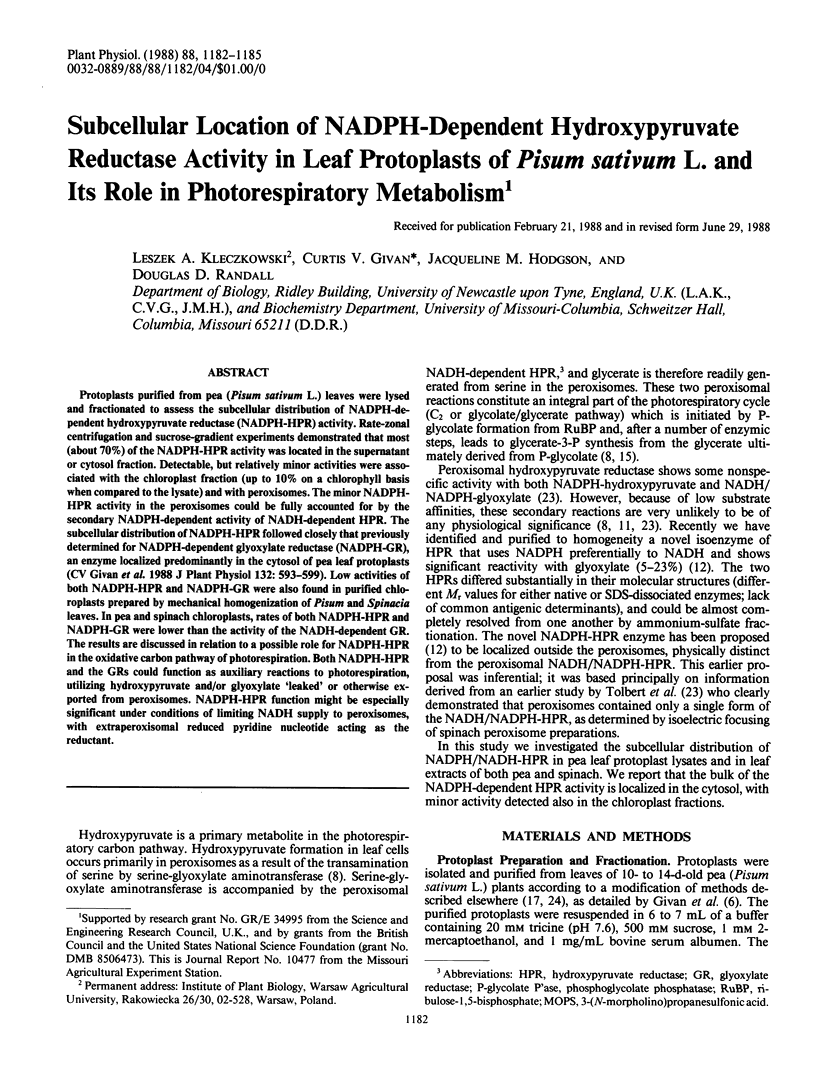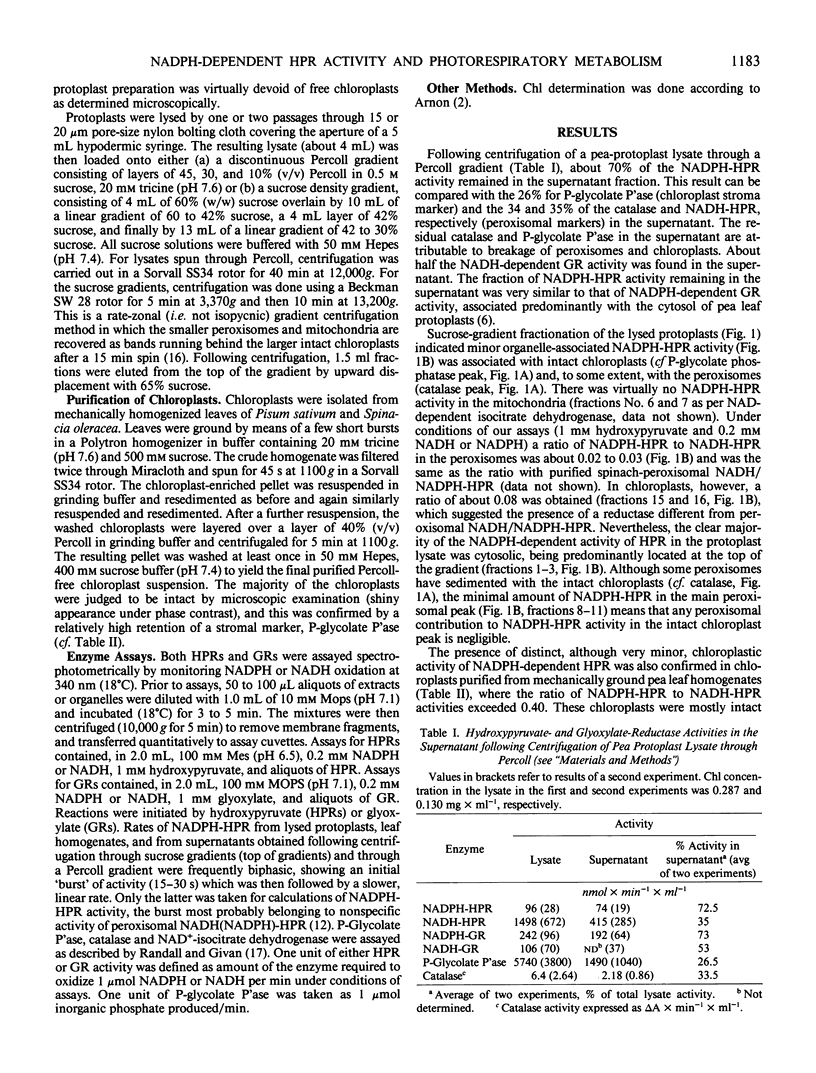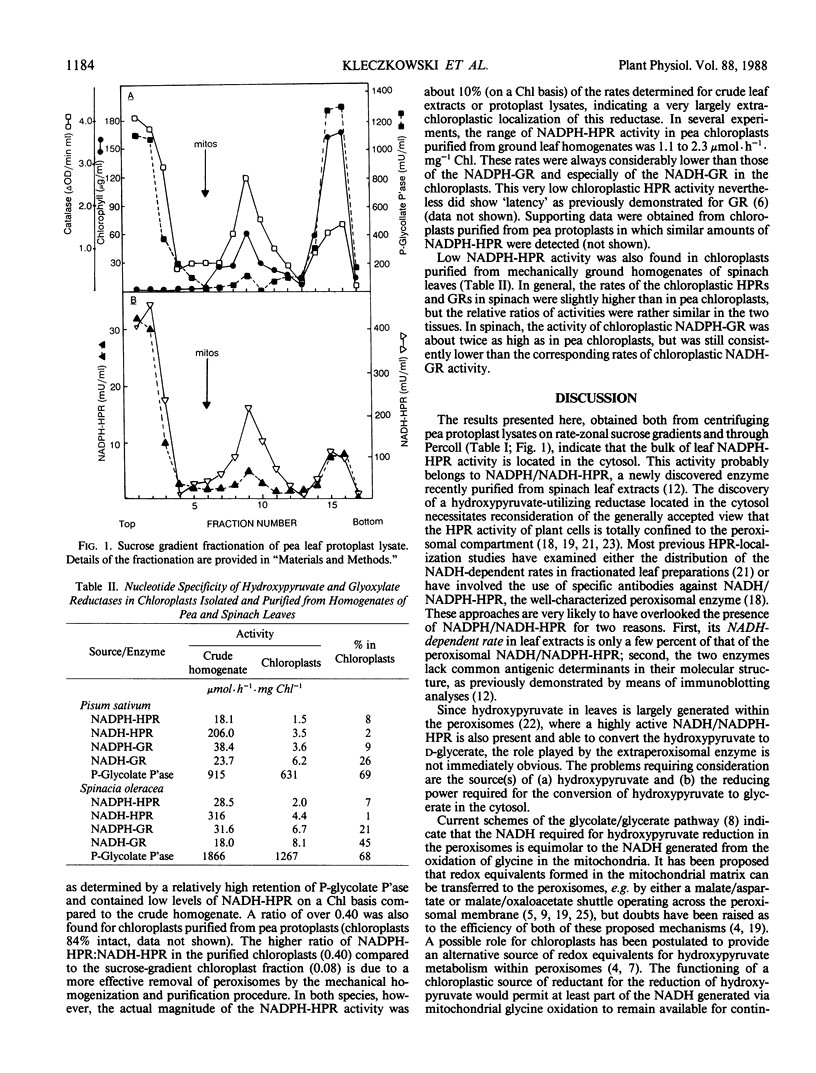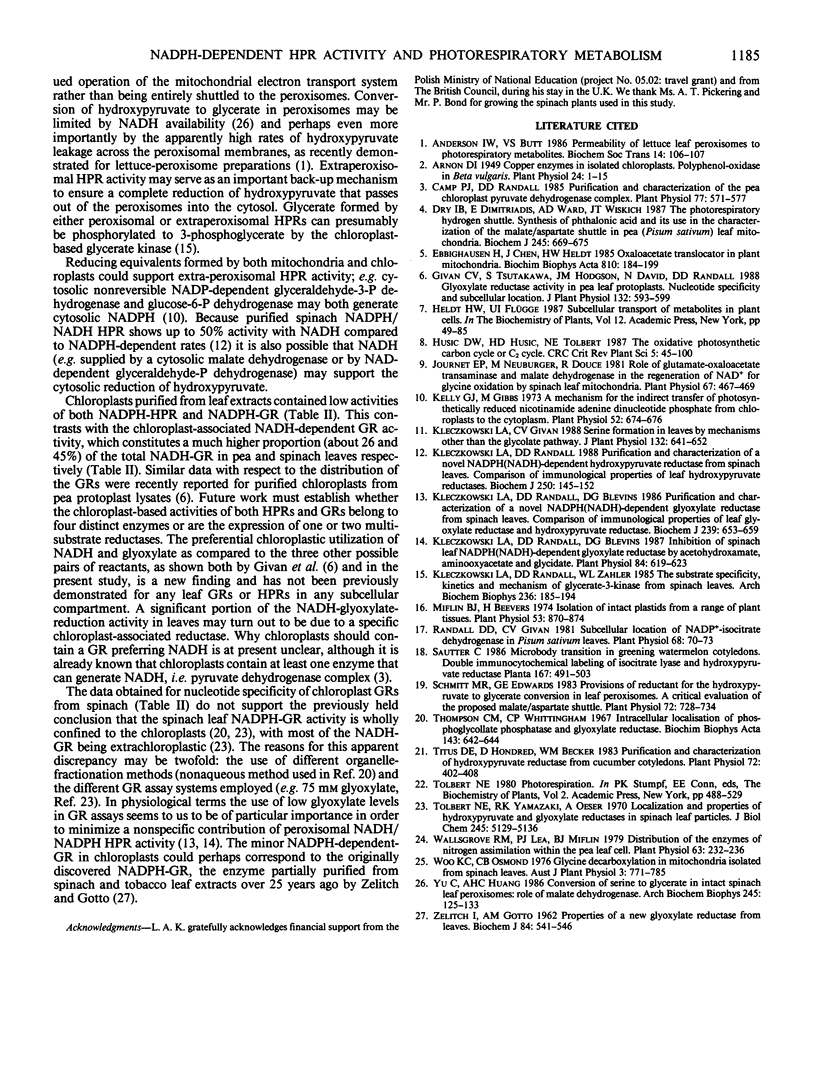Abstract
Protoplasts purified from pea (Pisum sativum L.) leaves were lysed and fractionated to assess the subcellular distribution of NADPH-dependent hydroxypyruvate reductase (NADPH-HPR) activity. Rate-zonal centrifugation and sucrose-gradient experiments demonstrated that most (about 70%) of the NADPH-HPR activity was located in the supernatant or cytosol fraction. Detectable, but relatively minor activities were associated with the chloroplast fraction (up to 10% on a chlorophyll basis when compared to the lysate) and with peroxisomes. The minor NADPH-HPR activity in the peroxisomes could be fully accounted for by the secondary NADPH-dependent activity of NADH-dependent HPR. The subcellular distribution of NADPH-HPR followed closely that previously determined for NADPH-dependent glyoxylate reductase (NADPH-GR), an enzyme localized predominantly in the cytosol of pea leaf protoplasts (CV Givan et al. 1988 J Plant Physiol 132: 593-599). Low activities of both NADPH-HPR and NADPH-GR were also found in purified chloroplasts prepared by mechanical homogenization of Pisum and Spinacia leaves. In pea and spinach chloroplasts, rates of both NADPH-HPR and NADPH-GR were lower than the activity of the NADH-dependent GR. The results are discussed in relation to a possible role for NADPH-HPR in the oxidative carbon pathway of photorespiration. Both NADPH-HPR and the GRs could function as auxiliary reactions to photorespiration, utilizing hydroxypyruvate and/or glyoxylate `leaked' or otherwise exported from peroxisomes. NADPH-HPR function might be especially significant under conditions of limiting NADH supply to peroxisomes, with extraperoxisomal reduced pyridine nucleotide acting as the reductant.
Full text
PDF



Selected References
These references are in PubMed. This may not be the complete list of references from this article.
- Arnon D. I. COPPER ENZYMES IN ISOLATED CHLOROPLASTS. POLYPHENOLOXIDASE IN BETA VULGARIS. Plant Physiol. 1949 Jan;24(1):1–15. doi: 10.1104/pp.24.1.1. [DOI] [PMC free article] [PubMed] [Google Scholar]
- Camp P. J., Randall D. D. Purification and Characterization of the Pea Chloroplast Pyruvate Dehydrogenase Complex : A Source of Acetyl-CoA and NADH for Fatty Acid Biosynthesis. Plant Physiol. 1985 Mar;77(3):571–577. doi: 10.1104/pp.77.3.571. [DOI] [PMC free article] [PubMed] [Google Scholar]
- Dry I. B., Dimitriadis E., Ward A. D., Wiskich J. T. The photorespiratory hydrogen shuttle. Synthesis of phthalonic acid and its use in the characterization of the malate/aspartate shuttle in pea (Pisum sativum) leaf mitochondria. Biochem J. 1987 Aug 1;245(3):669–675. doi: 10.1042/bj2450669. [DOI] [PMC free article] [PubMed] [Google Scholar]
- Journet E. P., Neuburger M., Douce R. Role of Glutamate-oxaloacetate Transaminase and Malate Dehydrogenase in the Regeneration of NAD for Glycine Oxidation by Spinach leaf Mitochondria. Plant Physiol. 1981 Mar;67(3):467–469. doi: 10.1104/pp.67.3.467. [DOI] [PMC free article] [PubMed] [Google Scholar]
- Kelly G. J., Gibbs M. A mechanism for the indirect transfer of photosynthetically reduced nicotinamide adenine dinucleotide phosphate from chloroplasts to the cytoplasm. Plant Physiol. 1973 Dec;52(6):674–676. doi: 10.1104/pp.52.6.674. [DOI] [PMC free article] [PubMed] [Google Scholar]
- Kleczkowski L. A., Randall D. D., Blevins D. G. Inhibition of Spinach Leaf NADPH(NADH)-Glyoxylate Reductase by Acetohydroxamate, Aminooxyacetate, and Glycidate. Plant Physiol. 1987 Jul;84(3):619–623. doi: 10.1104/pp.84.3.619. [DOI] [PMC free article] [PubMed] [Google Scholar]
- Kleczkowski L. A., Randall D. D., Blevins D. G. Purification and characterization of a novel NADPH(NADH)-dependent glyoxylate reductase from spinach leaves. Comparison of immunological properties of leaf glyoxylate reductase and hydroxypyruvate reductase. Biochem J. 1986 Nov 1;239(3):653–659. doi: 10.1042/bj2390653. [DOI] [PMC free article] [PubMed] [Google Scholar]
- Kleczkowski L. A., Randall D. D. Purification and characterization of a novel NADPH(NADH)-dependent hydroxypyruvate reductase from spinach leaves. Comparison of immunological properties of leaf hydroxypyruvate reductases. Biochem J. 1988 Feb 15;250(1):145–152. doi: 10.1042/bj2500145. [DOI] [PMC free article] [PubMed] [Google Scholar]
- Kleczkowski L. A., Randall D. D., Zahler W. L. The substrate specificity, kinetics, and mechanism of glycerate-3-kinase from spinach leaves. Arch Biochem Biophys. 1985 Jan;236(1):185–194. doi: 10.1016/0003-9861(85)90618-6. [DOI] [PubMed] [Google Scholar]
- Miflin B. J., Beevers H. Isolation of intact plastids from a range of plant tissues. Plant Physiol. 1974 Jun;53(6):870–874. doi: 10.1104/pp.53.6.870. [DOI] [PMC free article] [PubMed] [Google Scholar]
- Randall D. D. Subcellular Location of NADP-Isocitrate Dehydrogenase in Pisum sativum Leaves. Plant Physiol. 1981 Jul;68(1):70–73. doi: 10.1104/pp.68.1.70. [DOI] [PMC free article] [PubMed] [Google Scholar]
- Schmitt M. R., Edwards G. E. Provisions of reductant for the hydroxypyruvate to glycerate conversion in leaf peroxisomes : a critical evaluation of the proposed malate/aspartate shuttle. Plant Physiol. 1983 Jul;72(3):728–734. doi: 10.1104/pp.72.3.728. [DOI] [PMC free article] [PubMed] [Google Scholar]
- Thompson C. M., Whittingham C. P. Intracellular localisation of phosphoglycollate phosphatase and glyoxalate reductase. Biochim Biophys Acta. 1967;143(3):642–644. doi: 10.1016/0005-2728(67)90074-6. [DOI] [PubMed] [Google Scholar]
- Titus D. E., Hondred D., Becker W. M. Purification and characterization of hydroxypyruvate reductase from cucumber cotyledons. Plant Physiol. 1983 Jun;72(2):402–408. doi: 10.1104/pp.72.2.402. [DOI] [PMC free article] [PubMed] [Google Scholar]
- Tolbert N. E., Yamazaki R. K., Oeser A. Localization and properties of hydroxypyruvate and glyoxylate reductases in spinach leaf particles. J Biol Chem. 1970 Oct 10;245(19):5129–5136. [PubMed] [Google Scholar]
- Wallsgrove R. M., Lea P. J., Miflin B. J. Distribution of the Enzymes of Nitrogen Assimilation within the Pea Leaf Cell. Plant Physiol. 1979 Feb;63(2):232–236. doi: 10.1104/pp.63.2.232. [DOI] [PMC free article] [PubMed] [Google Scholar]
- Yu C., Huang A. H. Conversion of serine to glycerate in intact spinach leaf peroxisomes: role of malate dehydrogenase. Arch Biochem Biophys. 1986 Feb 15;245(1):125–133. doi: 10.1016/0003-9861(86)90196-7. [DOI] [PubMed] [Google Scholar]
- ZELITCH I., GOTTO A. M. Properties of a new glyoxylate reductase from leaves. Biochem J. 1962 Sep;84:541–546. doi: 10.1042/bj0840541. [DOI] [PMC free article] [PubMed] [Google Scholar]


